
The International Code of Zoological Nomenclature (ICZN) is a widely accepted convention in zoology that rules the formal scientific naming of organisms treated as animals. It is also informally known as the ICZN Code, for its publisher, the International Commission on Zoological Nomenclature. The rules principally regulate:

The Drosophilidae are a diverse, cosmopolitan family of flies, which includes species called fruit flies, although they are more accurately referred to as vinegar or pomace flies. Another distantly related family of flies, Tephritidae, are true fruit flies because they are frugivorous, and include apple maggot flies and many pests. The best known species of the Drosophilidae is Drosophila melanogaster, within the genus Drosophila, also called the "fruit fly." Drosophila melanogaster is used extensively for studies concerning genetics, development, physiology, ecology and behaviour. Many fundamental biological mechanisms were discovered first in D. melanogaster. The fruit fly is mostly composed of post-mitotic cells, has a very short lifespan, and shows gradual aging. As in other species, temperature influences the life history of the animal. Several genes have been identified that can be manipulated to extend the lifespan of these insects. Additionally, Drosophila subobscura, also within the genus Drosophila, has been reputed as a model organism for evolutionary-biological studies, along with D. sechellia for the evolution of host specialization on the toxic noni fruit and Scaptomyza flava for the evolution of herbivory and specialist on toxic mustard leaves.
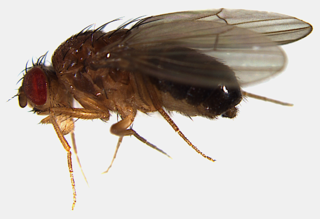
Drosophila funebris is a species of fruit fly. It was originally described by Johan Christian Fabricius in 1787, and placed in the genus Musca but is now the type species of the paraphyletic genus Drosophila. Drosophila funebris is a member of the Immigrans-tripunctata radiation of the subgenus Drosophila.

Eristalis is a large genus of hoverflies, family Syrphidae, in the order Diptera. Several species are known as drone flies because they bear a resemblance to honeybee drones.
The Drosophila melanogaster species group belongs to the subgenus Sophophora and contains 10 subgroups. The phylogeny in this species group is poorly known despite many studies covering many of the species subgroups. The most likely explanation is that the various subgroups diverged from each other in a relatively short evolutionary time frame. Three subgroups have not yet been investigated in molecular studies, and their position in the phylogeny is unclear. The suzukii subgroup is paraphyletic as D. lucipennis is systematically placed within the elegans subgroup.
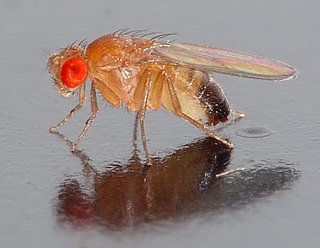
The paraphyletic subgenus Sophophora of the genus Drosophila was first described by Alfred Sturtevant in 1939. It contains the best-known drosophilid species, Drosophila melanogaster. Sophophora translates as carrier (phora) of wisdom (sophos). The subgenus is paraphyletic because the genus Lordiphosa and the species Hirtodrosophila duncani are also placed within this subgenus.

The Opetiidae is a family of true flies of the superfamily Platypezoidea, one of two families commonly called flat-footed flies. The family contains only five extant species in two genera, Opetia from the Palearctic region and Puyehuemyia from Chile in South America. Several fossil genera have been assigned to the family, but many of these are likely to belong elsewhere in the Platypezoidea. Lonchopterites from the Early Cretaceous Lebanese amber and Electrosania from the Late Cretaceous New Jersey amber seem likely to be closely related to modern opetiids.
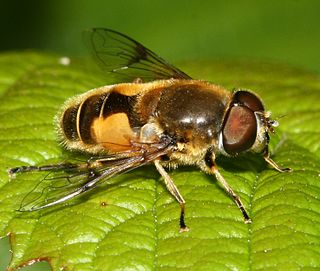
Eristalis horticola is a Palearctic species of hoverfly.

Hirtodrosophila is a genus of fruit flies from the family Drosophilidae. Originally Hirtodrosophila was a subgenus of the genus Drosophila. It was raised to the status of genus by Grimaldi in 1990.

Liancalus is a genus of flies in the family Dolichopodidae. It contains at least 21 species distributed worldwide except in Australasia and Oceania. The genus includes some of the largest species in the family, with body length approaching 12 mm in some species.
Oncopygius is a genus of flies in the family Dolichopodidae. It includes three living species in Europe, mainly recorded from montane habitats in Central and Southeastern Europe. Also associated with the genus are three extinct species known from fossils found in the Rott Formation of Germany, dated to the Oligocene.

Xanthochlorus is a genus of flies in the family Dolichopodidae. It is the only member of the subfamily Xanthochlorinae. In some classifications, the genus is included in the subfamily Sympycninae.
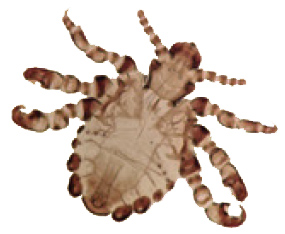
Pthirus is a genus of lice. There are only two extant species, and they are the sole known members of the family Pthiridae. Pthirus gorillae infests gorillas, and Pthirus pubis afflicts humans, and is commonly known as the crab louse or pubic louse. The two species diverged some 3.3 million years ago.
Culex vishnui is a mosquito belonging to the Culicidae family. It is the most common vector (carrier) of the Japanese encephalitis virus (JEV) in India, Sri Lanka, Thailand, and Sarawak.
Drosophila elegans is a flower-feeding species of fruit flies, belonging to the family Drosophilidae. It is found in Taiwan and the Philippines in Asia.
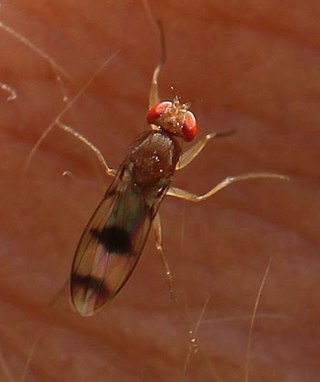
Chymomyza is a genus of vinegar flies.

Psilocurus is a genus of robber flies in the family of Asilidae. There are about 14 described species in Psilocurus.

Drosophila prolongata commonly referred to as the panda fly, is a fly of the family Drosophilidae. This species is endemic to southeast Asia. Males of this species express one of the most extreme reversed sexual size dimorphism in the Drosophilidae, making this species an interesting model organism for the study of sexual selection. Males also display remarkable copulation courtship behaviour.













